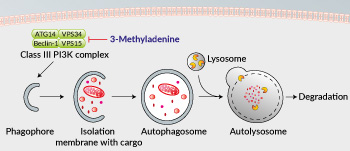3-Methyladenine
| Product | Unit size | Cat. code | Docs. | Qty. | Price | |
|---|---|---|---|---|---|---|
|
3-Methyladenine 3-MA, PI3K inhibitor |
Show product |
2 x 50 mg |
inh-3ma-2
|
|
PI3K inhibitor - Autophagy inhibitor

Inhibition of PI3K-III complex and autophagy by 3-MA
3-Methyladenine (also known as 3-MA) is an inhibitor of phosphatidylinositol 3-kinases (PI3K). PI3K plays an important role in many biological processes, including controlling the activation of mTOR, a key regulator of autophagy. Autophagy is a pathway by which cytoplasmic constituents, including organelles and intracellular pathogens, are sequestered in a double-membrane-bound autophagosome and delivered to the lysosome for degradation.
Mode of action:
3-Methyladenine inhibits autophagy by blocking autophagosome formation via the inhibition of the class III PI3K complex [1]. Interestingly, 3-Methyladenine appears to play a dual role in autophagy. Prolonged treatment with 3-Methyladenine promotes autophagy under nutrient-rich conditions, whereas 3-Methyladenine inhibits starvation-induced autophagy [1]. These results are attributed to differential effects on class I versus class III PI3K. It blocks class I PI3K persistently, whereas its suppressive effect on class III PI3K is transient [1].
In addition to its role in autophagy, 3-Methyladenine has been implicated in cancer therapy [2]. It has been revealed that 3-Methyladenine suppresses the invasion of highly metastatic cancer cells through the inhibition of class I and II PI3K [3].
Further studies demonstrated that 3-Methyladenine can induce caspase-dependent cell death that is independent of autophagy inhibition [4].
Key features:
- Phosphoinositide 3-kinase (PI3K) inhibitor
- An autophagy inhibitor
![]() Read our review on Autophagy and Innate Immunity
Read our review on Autophagy and Innate Immunity
References:
1. Wu Y. et al., 2010. Dual role of 3-methyladenine in modulation of autophagy via different temporal patterns of inhibition on class I and III phosphoinositide 3-kinase. J Biol Chem. 285(14):10850-61.
2. Cheong H et al., 2012. Therapeutic targets in cancer cell metabolism and autophagy. Nature Biotechnology 30:671–678.
3. Ito S. et al., 2007.3-Methyladenine suppresses cell migration and invasion of HT1080 fibrosarcoma cells through inhibiting phosphoinositide 3-kinases independently of autophagy inhibition. Int J Oncol 31 261-268.
4. Hou H. et al., 2012. Inhibitors of phosphatidylinositol 3'-kinases promote mitotic cell death in HeLa cells. PLoS One. 7(4):e35665.
Specifications
CAS number: 5142-23-4
Working concentration: 5 mM for cell culture assays
Formula: C6H7N5
Molecular weight: 149.2 g/mol
Solubility: 7.5 mg/ml (50 mM) in DMSO heated for 5 minutes at 55°C
Quality control:
- Purity ≥ 90% (UHPLC)
- The absence of bacterial contamination (e.g. lipoproteins and endotoxins) has been confirmed using HEK-Blue™ TLR2 and HEK-Blue™ TLR4 cells.
Contents
- 100 mg (2 x 50 mg) of 3-methyladenine
![]() 3-methyladenine is shipped at room temperature.
3-methyladenine is shipped at room temperature.
![]() Store at room temperature.
Store at room temperature.
Back to the top
Details
Autophagy
Autophagy is an orchestrated homeostatic process to eliminate unwanted proteins and damaged organelles [1-3]. The autophagic process is also used to remove intracellular microbial pathogens. Several signaling pathways sense different types of cell stress, ranging from nutrient deprivation to microbial invasion, and converge to regulate autophagy at multiple stages of the process. Autophagy starts with phagophore (also known as isolation membrane) formation, a step is initiated by a protein complex comprising UNC-51-like kinase 1 or 2 (ULK1 or ULK2) and Atg (autophagy-related genes) proteins. ULK1/2 then phosphorylates components of the class III phosphatidylinositol 3-kinase (PI3K) complex, whose formation is driven by Beclin 1. The phagophore elongates and isolates its cargo inside a closed structure termed autophagosome. The fusion of the lysosome with the autophagosome as an autophagolysosome (or autolysosome) allows the degradation of its contents.
References
1. Levine B. & Kroemer G., 2008. Autophagy in the pathogenesis of disease. Cell. 132(1):27-42.
2. Mizushima N. et al., 2008. Autophagy fights disease through cellular self-digestion. Nature. 451(7182):1069-75.
3. Netea-Maier R.T. et al., 2016, Modulation of inflammation by autophagy: Consequences for human disease. Autophagy. 12(2): 245–260.




